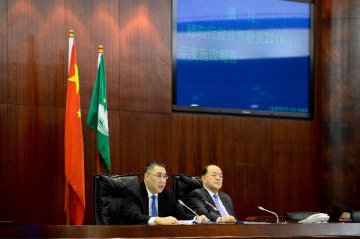
Mixed signals seem to be obscuring China's economic outlook. Foreign trade, a traditional engine of growth, ended 2015 with its first annual contraction in six years. Investment, another engine, also faltered, dragged down by a property market downturn and industrial overcapacity. Signs of economic stress are emerging: capital is leaving the country, bad debt is rising and financial market volatility is dampening confidence.
Yet that is not the full story. China's economy also has impressive underlying strengths, and policy makers have the determination to fix structural problems while containing risks. Economists forecast growth will continue to decline. "It will be in an L-shape trajectory for a while," said Liu Shijin, former deputy director of China's State Council Development Research Center. "But that will be a process of transformation and rebalancing."
CAUSE OF CONCERN
A stimulus package, while helping lift China's economy out of the mire of the global financial crisis, also fueled over-investment and over-building nationwide, leading to industrial overcapacity and a surplus in property supply that turned the manufacturing and property sectors from drivers to drags on growth, economists said.
Many economists, including State Information Center economist Zhu Baoliang, Bank of Communications chief economist Lian Ping and Zhong Zhengsheng, an economist with Caixin Insight Group, all labeled the property sector the biggest threat to the economy.
Growth of property investment, which used to account for about one-fifth of China's total investment and affects more than 40 other industries ranging from steel and cement to furniture, continued to decline. It fell to only 1.3 percent for the January-November period from the double-digit rises regularly reported until 2014.
Zhu expected property investment to register its first annual decrease this year, the first time in over a decade, as property development remained constrained by property developers' excess property inventories, which he estimated at 150 million units.
Despite stagnating economic growth, sustained poor performance of the property sector could breed financial risks, Zhong Zhengsheng warned. Another major concern lies in the industrial sector, which is awash with excess capacity that is driving down profits and threatens to further destabilize the already slowing growth.
Industrial overcapacity is not a new problem, but it was exacerbated by the 2009 stimulus package and continued to worsen despite the government's efforts to curtail it in recent years. China's industrial output growth slowed to 6.2 percent in November, a slight rebound from October, from the double-digit rates regularly recorded previously.
BACK-UP POWER
With traditional growth engines losing steam, China has been striving to foster new growth momentum, and there are glimmers of hope. First of all, a much-needed shift to domestic consumption-led growth is just getting underway.
Consumption, already responsible for 58.4 percent of growth, keeps going strong despite the economic slowdown. Take tourism for example: in 2015, Chinese citizens made over four billion trips at home and 120 million trips overseas, ranking first globally.
In addition to rising disposable income, the government's efforts to improve the country's social security net also act as a boost. Health insurance, pension insurance and free schooling seem to have helped keep Chinese people's propensity to save in check.
However, China still has a lot of room to catch up, compared with the United States, where consumption contributes 70 percent of economic growth, said Wang Xinjie, an analyst with Standard Chartered Bank (China).
Still more important is a change in economic structure. Services replaced industry as the biggest part of the national economy, and the gap has widened. In 2014, services accounted for 48.2 percent of the GDP, while industry's share was down to 42.6 percent.
The booming services sector enabled China to generate more jobs at lower levels of growth due to their labor-intensive nature. Although growth dipped to its lowest level in a quarter of a century last year, China created about 13 million new urban jobs.
CHANGING COURSE
It would be unrealistic to expect the rebalancing alone to spare the Chinese economy from trouble. Reforms, which were less imperative while growth galloped along, are now more pressing. Supply-side reform, a buzzword used by Chinese leaders and economists, will be the remedy for China's economic ills and the key to future growth for the year ahead and beyond.
"Supply-side structural reform is an urgent task that cannot afford any delay, otherwise the 'sickness' will become graver," the People's Daily cited an authoritative figure as saying in an exclusive interview last week.
The People's Daily, the flagship newspaper of the ruling Communist Party of China, did not disclose the name of the figure, but the term "authoritative figure" is usually used for high-level officials. Instead of quantitative easing, China has shifted to measures designed to increase the supply of high-quality goods and services, lower enterprises' costs, and boost consumption. These include stimulating business through tax cuts, entrepreneurship and innovation while phasing out excess capacity.
In the medium and long term, forceful supply-side reform can improve growth expectations in the household and corporate sectors, boosting consumption and investment, Liu Liu, an analyst with China International Capital Corp., said in a note.
Liu dismissed concerns that supply-side reform will have a significant negative impact on short-term growth, saying "recent policy moves show the government does not want to see a dramatic decline in growth in the short term, and that macroeconomic policy will be adjusted flexibly according to changes in the economy."




















Latest comments